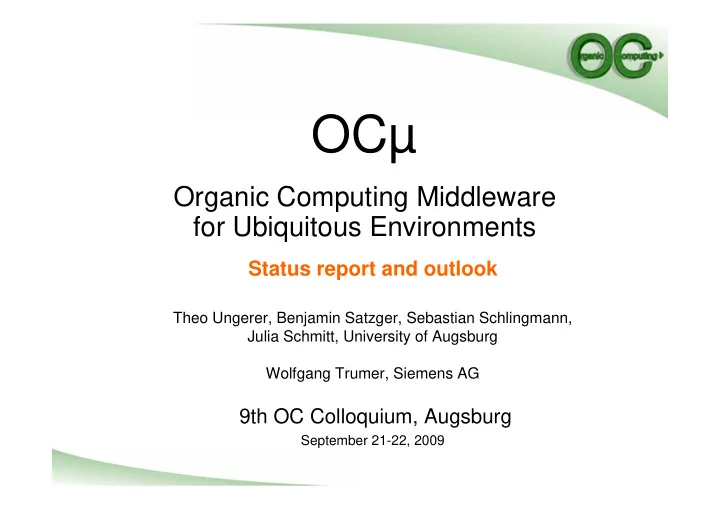

OCµ Organic Computing Middleware for Ubiquitous Environments Status report and outlook Theo Ungerer, Benjamin Satzger, Sebastian Schlingmann, Julia Schmitt, University of Augsburg Wolfgang Trumer, Siemens AG 9th OC Colloquium, Augsburg September 21-22, 2009
Outline • Status report (1 st & 2 nd phase) – Architecture of OCµ • Self-configuration • Self-optimization • Self-healing • Self-protection – Achievements and Problems • Outlook – Ailments and Cures – New OCµ Architecture (3 rd phase) – Further research • Summary DFG 1183 ORGANIC COMPUTING 2
Architecture of OCµ • Service-oriented middleware for smart environments • Sophisticated monitoring by monitor queues • Organic Managers on each node – System monitors – Include self-x services • Software developed in Java, currently based on JXTA and implemented on networked PCs • Application prototype: Smart Doorplates DFG 1183 ORGANIC COMPUTING 3
Architecture of an OCµ Node Organic Manager ServiceProxy Application Self-X Basic Services Services Services EventDispatcher Monitor Information Pool OutgoingMonitorQueue IncomingMonitorQueue SystemMonitor Information Pool TransportConnector OutgoingMonitorQueue IncomingMonitorQueue SystemMonitor JXTATransportConnector DFG 1183 ORGANIC COMPUTING 4
Self-configuration Service by Dr. Wolfgang Trumler • Task: Initial system configuration • Based on cooperative social behavior • Nodes negotiate service distribution under configuration constraints • Distributed and decentralized approach DFG 1183 ORGANIC COMPUTING 5
Self-optimization Service by Dr. Wolfgang Trumler • Task: Runtime load-balancing • Inspired by artificial hormone system • Nodes append workload values to messages • Four transfer strategies to decide upon service relocation DFG 1183 ORGANIC COMPUTING 6
Self-protection Service by Dr. Andreas Pietzowski • Task: Protect against attacks, identify malicious messages • Authorization system for services • Role management for nodes • Detection of malicious messages – Computer immunology approach – Generation, distribution, update of antibodies • Defense against threats DFG 1183 ORGANIC COMPUTING 7
Self-healing Service by Dr. Benjamin Satzger • Task: Recovery after system failures • Failure detection – Accrual failure detection algorithm – Grouping for scalability • Failure recovery engine – Automated distributed planning – User specifies the desired system properties – System: • Consistency check • Automated planning • Plan execution DFG 1183 ORGANIC COMPUTING 8
Achievements and Problems • All self-X services are well investigated, implemented and evaluated on simulators as well as on the middleware running a Smart Doorplate application • The self-X services partly use the same monitor database, but are not interconnected – No synergy between the different algorithms exists so far • The automated distributed planning of the self-healing service can be resource-intensive and takes a long time DFG 1183 ORGANIC COMPUTING 9
Outline • Status report (1 st & 2 nd phase) – Architecture of OCµ • Self-configuration • Self-optimization • Self-healing • Self-protection – Achievements and Problems • Outlook – Ailments and cures – New OCµ Architecture (3 rd phase) – Further research • Summary DFG 1183 ORGANIC COMPUTING 10
Ailments and Cures • No synergy between the different self-X algorithms exist – Cure: Integrate self-configuration, self-optimization and self- healing more closely using the same planning engine • Automated distributed planning takes a long time – Cure: two-level planner with • an elaborate High-level Planner and • Low-level Reflexes • Automated distributed planning is resource-intensive – Cure: Implement only reflexes on resource-restricted nodes DFG 1183 ORGANIC COMPUTING 11
New OCµ Architecture (3 rd phase) DFG 1183 ORGANIC COMPUTING 12
Further research (1) • New DFG Research Group OC-TRUST targets to add Trust mechanisms to Organic Computing – University of Augsburg (Reif, Andrè, Ungerer) – University of Hanover (Müller-Schloer, Hähner) • Work to be done at Chair of Systems and Networking: – Decide upon trust models, metrics, and values – Improve self-x algorithms by • adding trust values to decide and by • generating trust values byself-x algorithms for other self-x algorithms – Implement trust techniques in OCµ DFG 1183 ORGANIC COMPUTING 13
Further research (2) • FP-7 Project TERAFLUX on future many-cores (start 2010) Our Objective: Core and link failure detection – Previous research: adaptive routing in NoC applying the hormone-based self-optimization techniques (Sebastian Schlingmann) – Current research: task placement on many-cores with faulty elements (Sebastian Schlingmann) – Our approach within TERALUX: apply OC techniques to improve reliability • DFG project CarSoC (together with Uwe Brinkschulte): AC/OC techniques targeting (hard) real-time systems DFG 1183 ORGANIC COMPUTING 14
Further research (3) • Migrating OCµ to a Java many-core processor based on Jamuth/Komodo cores – The „Augsburg Many-core“: A 200-300 core processor will be implemented on 64 interconnected Altera FPGAs – OCµ Transport connector must be adapted – Suitability of OCµ middleware and self-X techniques for resource- limited cores – Objectives: Investigate OC techniques for • reliability and fault-tolerance, • load-balancing, and • automatic task distribution. DFG 1183 ORGANIC COMPUTING 15
Summary • Status of OCµ SPP project – OCµ prototype matured – Self-x algorithms implemented and investigated • Self-configuration • Self-optimization • Self-healing • Self-protection • 3 rd phase – Improved Organic Manager – two-level planning approach – Unified basis for self-x algorithms • Further research going on towards Trust and Many-cores DFG 1183 ORGANIC COMPUTING 16
Recommend
More recommend